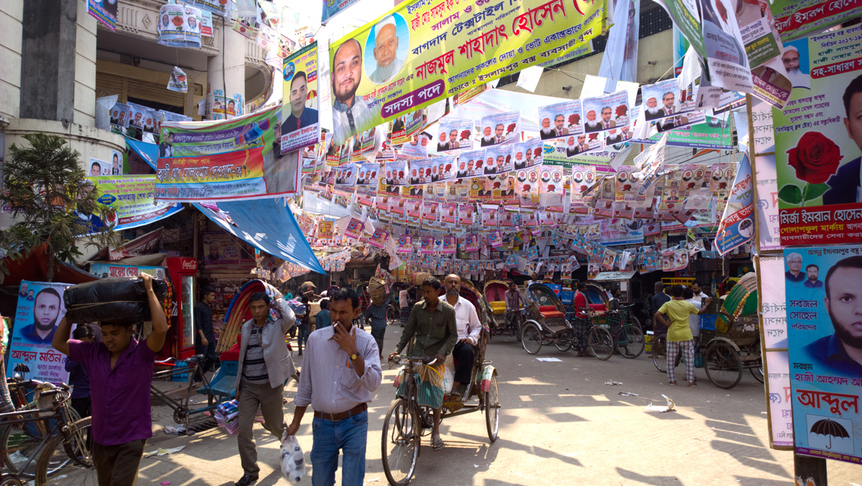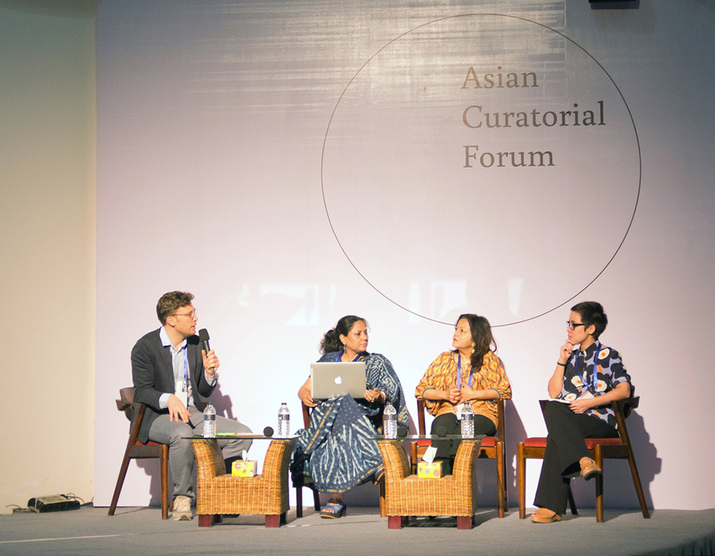
R
E
V N
E
X
T
Tiny steel cages, often decorated with hand-painted scripts or embroidered floral arrangements, are attached to an engine and three wheels to ferry clients from origin to destination in Dhaka. Sheet metal skin of buses stretch over tough frames, paint scratched off due to years of scrapes, collisions and hard driving on unforgiving roads. Here, vehicular navigation is a combination of wrenching, inching forward, stalling (for those with manual transmission) and waiting. Even at midnight, it can take over an hour to travel a couple hundred meters. It’s draining for both passenger and driver, but inter-vehicle gazes can meet through layers of glass—and, if you’re lucky, a bright smile shines through.
For fresh visitors, like this one, gridlock defined the Bangladeshi capital. A university student told me that many residents spend four or five hours in cars or buses each day, waiting to get from home to school or work, then back. The daily commute becomes a time for social interaction, in person or via smartphones, so privacy and personal space are luxuries. The ever-present obstacle of flesh, exhaust and scrap metal has not stopped foreign money from flooding into the South Asian nation—the Chinese state-owned munitions, firearms and military vehicle manufacturer Norinco is developing office buildings, hotels and convention centers, kicking up even more dust to transform Dhaka’s skyline.
In that shifting landscape, both figuratively and literally, “the word ‘curator’ may not have a settled meaning,” said Luva Nahid Choudhury director general of the Bengal Foundation, who organized—along with Dhaka’s Britto Arts Trust, Taiwan’s National Culture and Arts Foundation and the Kuandu Museum of Fine Arts—the first Asian Curatorial Forum at Bangladesh Shilpakala Academy. From February 9 to 11, 2017, representatives from Bangladesh, mainland China, India, Malaysia, the Maldives, Nepal, Sri Lanka, Taiwan, Thailand, and Vietnam met to present examples of their own curatorial work, share fresh ideas and even lay the groundwork for future collaborations.
DAY 1
The forum was divided into four panels, with two taking place on the first day. Under the moderation of Bengal Foundation visual arts program advisor Hadrien Diez, Bangladeshi artist-curator Tayeba Begum Lipi echoed Choudhury’s sentiment and discussed the curator’s perimeter of action by recalling that it was not until recently that the nation had professional curators, so enterprising artists had to take up the responsibility. With practically nonexistent resources, Lipi herself slipped into such a role. Kathmandu-based Sangeeta Thapa also pointed out that she had never received training as a curator. In 1983, she returned to Nepal, and four years later founded the Siddhartha Art Gallery—“the only gallery to reject artworks” in Nepal. Thapa shared anecdotes from her professional development, including tales of Western romanticization of “art from the Himalayas,” and quoted Bangladeshi artist Kalidas Karmakar: “I don’t understand this curator, curator business. I am telling you the curator is now God and the artist is Dog.” Pichaya Aime Suphavanij, who is the head of exhibitions at the Bangkok Arts and Culture Centre, suggested that the free flow of goods and capital facilitated by ASEAN agreements has even impacted the health of Thailand’s art scene—with practically no art market at home, it is in Singapore where Thai art finds buyers. As such, a mere two percent of Thai art students become professional artists.
The second discussion of the day was about transcending the local context. Moderator Nobuo Takamori, curator at Taipei’s Kuandu Museum of Fine Arts, primed the panelists by describing a shift in the artistic and curatorial mindset: Are we modern enough? Are we avant-garde enough? Are we contemporary enough? Are we global enough? Umair Badeeu, an independent curator from Malé, indicated a major problem in the Maldives: there are no art schools, and only one commercial gallery that is located in a resort, but many artists scrape by while serving the tourist industry. Art initiatives in the Maldives are occasionally funded by non-governmental organizations such as UNICEF, but authentic voices are still stifled by conditions on the ground, including the lack of art spaces and the “review” of artworks by the National Center for Arts before they are exhibited. Lian Heng Yeoh, who founded Kuala Lumpur art space Lostgens, illustrated what successful community engagement can look like. By collecting old objects and recording dialects that are fading into obsolescence, and then staging a show that braided these cultural threads, Yeoh found that it was the elderly who were drawn in; these older visitors then revisited the show with younger members of their families. Following that train of thought, Feng Feng, course director of the Guangzhou Academy of Fine Arts, shared examples of his own work along with his wife’s, to demonstrate that creating and exhibiting art can be a family affair.
DAY 2
Naeem Mohaiemen, a researcher from New York’s Columbia University, moderated the third panel discussion, which was about shaping new conversations. Nien Pu Alice Ko, an independent curator from Taiwan, introduced a project rooted in the Shibuya Incident, a violent confrontation between Yakuza gang members and “third-country” nationals from Formosa (now Taiwan) in postwar Japan. Ko invited artists from Japan and Taiwan to dig through archives in their own countries and respond to tensions in East Asia—tensions that persist even now, seven decades later. New Delhi-based Vidya Shivadas, director of the Foundation for Indian Contemporary Art, said she was also interested in artists’ treatments of archives, and indicated records of the devastating Bhopal gas tragedy as one such example. Ho Chi Minh City’s Nhu Huy Nguyen, who founded Zero Station, departed from the “macro” responses described by Ko and Shivadas, and showed footage of a collaborative project called “When Everything Becomes Music” (2013), in which artists entered a residential area and borrowed household items to use as makeshift instruments. Sharmini Pereira, founder of Raking Leaves in Colombo, declared, “I am a curator.” She explained that Sri Lankan artists often did not have catalogues; a lack of shelf presence often led to a lack of validation or recognition beyond their own national borders. Hence, Pereira proposed that these books are also artworks, made with artists.
DAY 3
Mustafa Zaman, the editor of Dhaka’s Depart magazine, moderated the final day’s panel, which addressed the generation of new perspectives on old narratives. Haema Sivanesan, curator at the Art Gallery of Greater Victoria and curatorial advisor for the Bengal Foundation, kickstarted the conversation by saying, “The culture of exhibition-making and exhibition-going is very new” in Bangladesh, and focused on this exciting aspect of formalizing a curatorial practice from the ground up in the country. Takamori followed by mapping the origins of the Nanyang Style, tracking influences from the Philippines, Tokyo, Taiwan, Xiamen, Singapore, Belgium and Bali—indicating that curatorial work in Asia is “not just about single countries, but about multiple layers.” Nguyen stepped back from his “micro” engagements to introduce Phan Quang’s “Re/cover” photography project (2011), in which the artist captured portraits of the abandoned offspring of Japanese soldiers who were stationed in Vietnam during World War II, as well as the women who birthed them.
One of the off-site exhibition locations for the 9th edition of Chobi Mela was a disused cinema called Northbrook Hall in Old Dhaka.
CONCLUSION
Driving home her point from the first day, Lipi said, “Everything starts from need.” Sivanesan observed that the curators present at the forum strive despite many limitations. Staying true to her heritage, Suphavanij drew an analogy from Thai boxing, and said that those who aim to succeed must “fight up close.”
Conversations meandered beyond the forum, spilling into shared car rides, onto lunch tables, and into the galleries of the 9th edition of Chobi Mela, a two-week international photography biennial that was held at the same venue, with off-site exhibitions in Old Dhaka as well. Some curators shared personal anecdotes that were beyond the scope of the prescribed topics. Nguyen intimated that he had visited a police station in Ho Chi Minh City to give a lecture, in an attempt to educate local law enforcers about contemporary art and, in a small way, counter the restrictions that art practitioners face in Vietnam. Other practitioners also think outside the box, and act according to the conditions they face at home, on the ground.
Brady Ng is Hong Kong desk editor at ArtAsiaPacific.
To read more of ArtAsiaPacific’s articles, visit our Digital Library.





